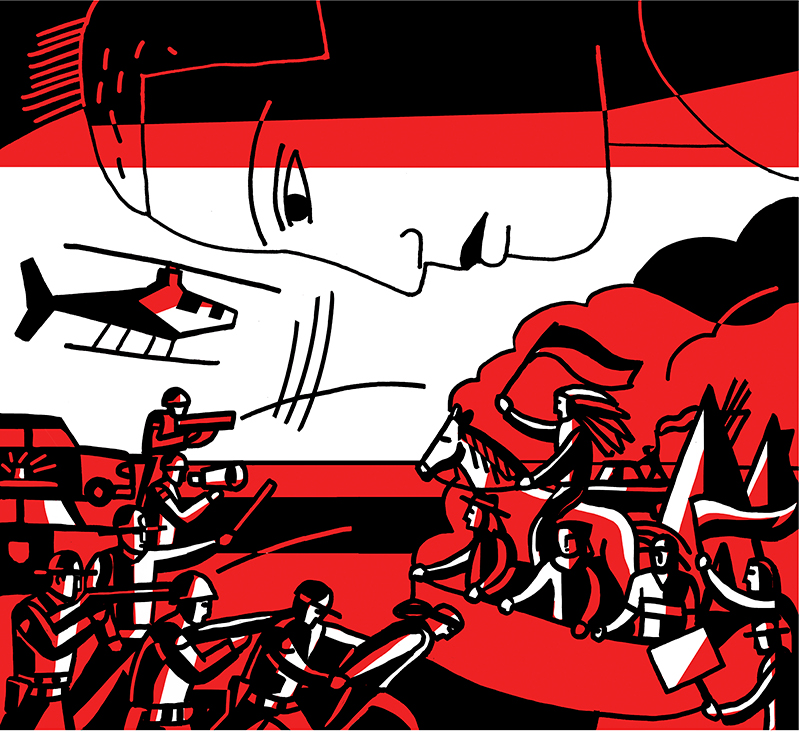A corporate helicopter circled low overhead. It was in the no-fly zone, surveilling the crowd. A piercing smoke alarm—called a sound canon, I’d learn—was deafening, even dizzying, as if I’d placed my ear on the amplifier at a heavy metal concert. All around me, police were macing unarmed people—peaceful “water protectors”—and firing off beanbag shotguns and tear gas cartridges. I spent hours in the middle of this chaos. By the time I left, police had arrested more than 140 people.
This was three years ago. Charles Fenster ’79 and I had set out at dawn, driving five hours from Brookings, S.D., where we both lived, to Cannon Ball, N.D., and the Standing Rock Indian Reservation to observe one of the largest gatherings of Natives in modern history.
We’d arrived that day at the Dakota Access Pipeline at the request of a tribal member employed by Sitting Bull College—Standing Rock Reservation’s tribal college—who’d asked us to serve as witnesses. We were also curious. The local media accounts had differed widely from firsthand reports by Native friends and relatives. We wanted to know what was really happening.
I am an Oglala Sioux tribal member from the Pine Ridge Indian Reservation in western South Dakota. I am also a cultural anthropologist—one of three in all of South Dakota. A rarity in both my state and my discipline, I am one of fewer than 100 American Indians in more than a century to hold a Ph.D. in anthropology. Besides me, there’s been only one other Ph.D. anthropologist, ever, who was Lakota: Beatrice Medicine. Her most prominent work? Learning to Be an Anthropologist & Remaining Native.

There’s a reason why my peer group is so small. In my community, the term Native anthropologist is commonly viewed as an oxymoron. In his book Custer Died for Your Sins, the late Vine Deloria Jr. wrote a chapter titled “Anthropologists and Other Friends,” depicting anthropologists as bourgeois, white, dominant-culture vultures who prey on Native communities. To many in college-educated Native circles, anthropologists only seem to be around to make careers off of our colonized struggles.
That was my model for the profession growing up. But I became an anthropologist nonetheless, in part because it provided a vocabulary to connect my two distinctly different families. My dad is an Irish Catholic from Lawrence, Mass. He and my mother met on the Rosebud Indian Reservation in the 1970s. My mom’s family are first-language Lakota speakers. Anthropology helped me to bridge those cultural spaces.
At Standing Rock, I did my job as an anthropologist, observing patterns and culture firsthand. In doing so, I reflected on what it means, in practice, to be a Native anthropologist. It means that while my heart is tethered to wolakota—that is, to peace and the culture itself—my professional training enables me to detach from the immediacy of my emotions, to strive for a scientific outlook and quest for truth.
And what is that truth? In class, my students and I discuss notions of insider and outsider research. Often, there are advantages to each. Yet the best anthropology requires a holistic view that incorporates both, in which a grasping of theory is informed by lived experience. I wonder what it means for society when people fail to bridge ideological and theoretical politics with a firsthand lived experience.
I went to Standing Rock to reach my own conclusion, but now I know I never will, at least not in the way I’d originally formed my question. This is the conundrum of being a Native anthropologist in the 21st century. It is to know that people crave a simplistic framing to a complicated dilemma: Is a pipeline good or bad? But let’s instead ask: Do tribal people in the United States have the ability to determine their own economic destiny? I went to Standing Rock in search of an answer, but all I found was a better question.
Meyers is on the faculty at Oglala Lakota College, where he is also the interim director of graduate studies. He is a past president of the Association of Indigenous Anthropologists and a former writer/editor in Indian Affairs at the U.S. Department of the Interior in Washington, D.C.
Illustration by Anthony Russo